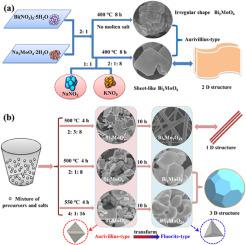当前位置:
X-MOL 学术
›
J. Alloys Compd.
›
论文详情
Our official English website, www.x-mol.net, welcomes your
feedback! (Note: you will need to create a separate account there.)
Engineering the dimension and crystal structure of bismuth molybdate photocatalysts via a molten salt-assisted assembly approach
Journal of Alloys and Compounds ( IF 5.8 ) Pub Date : 2020-12-01 , DOI: 10.1016/j.jallcom.2020.156231 Gui Yang , Yujun Liang , Kai Li , Jian Yang , Kun Wang , Rui Xu , Xianjun Xie
Journal of Alloys and Compounds ( IF 5.8 ) Pub Date : 2020-12-01 , DOI: 10.1016/j.jallcom.2020.156231 Gui Yang , Yujun Liang , Kai Li , Jian Yang , Kun Wang , Rui Xu , Xianjun Xie

|
Abstract In this work, a facile molten salt-assisted assembly strategy was studied to achieve controlled synthesis of bismuth molybdate photocatalysts including Bi2MoO6, Bi6Mo2O15, Bi4MoO9 and Bi14MoO24. The transition of bismuth molybdates from Aurivillius-type to Fluorite-type could be selectively and efficiently achieved by adjusting the molten salt synthesis time. It was observed that the bismuth molybdate samples exhibited an obvious redshift in the absorption band with increasing of Bi/Mo molar ratio (from 3 to 14) in the materials, indicating a reduced band-gap. As a result, the photocatalytic activity of the Fluorite-type Bi14MoO24 sample for TC removal was higher than that of Bi2MoO6, Bi6Mo2O15 and Bi4MoO9 samples under a visible light irradiation. Furthermore, the mechanisms of phase change between Aurivillius-type and Fluorite-type as well as their band structures of the bismuth molybdates were systematically investigated in this work. This study not only provides a new strategy for the controlled synthesis of bismuth molybdates with different dimensionalities and structures, but also opens a new pathway to the design and optimization of advanced bismuth molybdates-based photocatalysts for applications in energy harvesting and environmental remediation.
中文翻译:

通过熔盐辅助组装方法设计钼酸铋光催化剂的尺寸和晶体结构
摘要 在这项工作中,研究了一种简便的熔盐辅助组装策略,以实现钼酸铋光催化剂的可控合成,包括 Bi2MoO6、Bi6Mo2O15、Bi4MoO9 和 Bi14MoO24。通过调节熔盐合成时间,可以有选择地、高效地实现钼酸铋从Aurivilius型到萤石型的转变。观察到随着材料中 Bi/Mo 摩尔比(从 3 到 14)的增加,钼酸铋样品在吸收带中表现出明显的红移,表明带隙减小。因此,在可见光照射下,萤石型 Bi14MoO24 样品的 TC 去除光催化活性高于 Bi2MoO6、Bi6Mo2O15 和 Bi4MoO9 样品。此外,在这项工作中系统地研究了Aurivilius型和萤石型之间的相变机制以及它们的钼酸铋的能带结构。该研究不仅为不同维度和结构的钼酸铋的可控合成提供了一种新策略,而且为设计和优化先进的钼酸铋基光催化剂用于能量收集和环境修复开辟了新途径。
更新日期:2020-12-01
中文翻译:

通过熔盐辅助组装方法设计钼酸铋光催化剂的尺寸和晶体结构
摘要 在这项工作中,研究了一种简便的熔盐辅助组装策略,以实现钼酸铋光催化剂的可控合成,包括 Bi2MoO6、Bi6Mo2O15、Bi4MoO9 和 Bi14MoO24。通过调节熔盐合成时间,可以有选择地、高效地实现钼酸铋从Aurivilius型到萤石型的转变。观察到随着材料中 Bi/Mo 摩尔比(从 3 到 14)的增加,钼酸铋样品在吸收带中表现出明显的红移,表明带隙减小。因此,在可见光照射下,萤石型 Bi14MoO24 样品的 TC 去除光催化活性高于 Bi2MoO6、Bi6Mo2O15 和 Bi4MoO9 样品。此外,在这项工作中系统地研究了Aurivilius型和萤石型之间的相变机制以及它们的钼酸铋的能带结构。该研究不仅为不同维度和结构的钼酸铋的可控合成提供了一种新策略,而且为设计和优化先进的钼酸铋基光催化剂用于能量收集和环境修复开辟了新途径。





















































 京公网安备 11010802027423号
京公网安备 11010802027423号